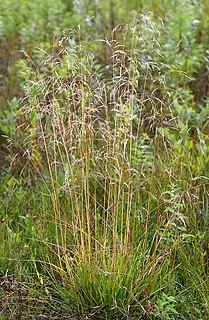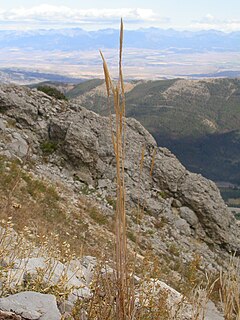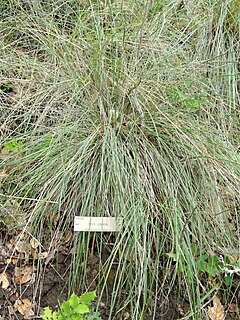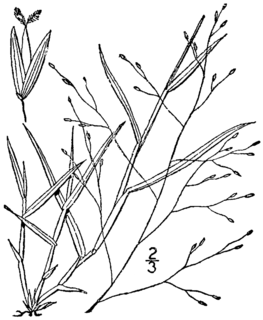
Deschampsia cespitosa, commonly known as tufted hairgrass or tussock grass, is a perennial tufted plant in the grass family Poaceae. Distribution of this species is widespread including the eastern and western coasts of North America, parts of South America, Eurasia and Australia.

Deschampsia is a genus of plants in the grass family, commonly known as hair grass or tussock grass. The genus is widespread across many countries.

Danthonia californica is a species of grass known by the common name California oatgrass. This plant is native to two separate regions of the Americas, western North America from California to Saskatchewan, and Chile.

Festuca idahoensis is a species of grass known by the common names Idaho fescue and blue bunchgrass. It is native to western North America, where it is widespread and common. It can be found in many ecosystems, from shady forests to open plains grasslands.

Aira praecox is a species of grass known by several common names, including early hair-grass, yellow hairgrass and spike hairgrass. It is native to Europe, where it is found in dry, sandy places, on rocky outcrops, and in heath grassland. It also grows in North America as an introduced species, where it can be found on the east and west coasts in sandy or rocky areas, such as beaches and roadsides. This is a tuft-forming annual grass growing up to about 25 centimeters in maximum height. The thin, narrow leaves are located at the base of the stem, and are typically 0.3–2 millimeters wide. It bears very small inflorescences of purple-tinted green bisexual spikelets.

Achnatherum occidentale is a species of grass known by the common name western needlegrass. It is native to western North America from British Columbia to California to Colorado, where it grows in many types of habitat. This is a tufting perennial bunchgrass forming tight clumps of erect stems up to about 120 centimetres (47 in) in maximum height, but sometimes much shorter. The hairlike leaves are less than a millimeter wide and may have rolled edges. The inflorescence is up to 30 centimetres (12 in) long, with each hairy spikelet bearing an awn up to 4 or 5 centimeters long. The awn is kinked twice.

Briza minor is a species of grass known by the common names lesser quaking-grass or little quakinggrass. It is native to the Mediterranean Basin, and it is known elsewhere, including much of North America, as an introduced species. It is an annual grass producing narrow clumps of erect stems up to 50 centimeters tall. The inflorescence bears several small cone-shaped spikelets, each hanging on a pedicel.

Deschampsia danthonioides is a species of grass known by the common name annual hairgrass. It is native to western North America from the Yukon Territory and British Columbia, through California and the Western United States, to Baja California, and also to southern South America in Chile and Argentina.

Poa leptocoma is a species of grass known by the common names marsh bluegrass and western bog bluegrass.

Puccinellia lemmonii is a species of grass known by the common name Lemmon's alkaligrass. It is native to western North America, particularly the northwestern United States, where it grows in moist, saline soils.

Tripidium ravennae, synonym Saccharum ravennae, with the common names ravennagrass and elephant grass, is a species of grass in the genus Tripidium. It is native to southern Europe, western Asia and South Asia and is known in North America as an introduced species, where it is sometimes an invasive and troublesome noxious weed.

Schismus barbatus is a species of grass known as common Mediterranean grass and kelch-grass. It is native to Eurasia, and it is also known as an introduced species in the southwestern United States. It grows in many habitats, including disturbed areas. It is an annual grass growing in small clumps. The stems grow up to 27 centimeters long and are lined with threadlike leaves. The short inflorescence bears spikelets under a centimeter long.

Spartina densiflora is a species of grass known by the common name denseflower cordgrass. It has been reclassified as Sporobolus montevidensis after a taxonomic revision in 2014, but Spartina densiflora is still in common usage. It is native to the coastline of southern South America, where it is a resident of salt marshes. It is also known on the west coast of the North America and parts of the Mediterranean coast as an introduced species and in some areas a noxious weed. In California it is a troublesome invasive species of marshes in San Francisco Bay and in Humboldt Bay, where it was introduced during the 19th century from Chile in ballast.

Sporobolus contractus is a species of grass known by the common name spike dropseed. It is native to western North America, including the southwestern United States and northern Mexico. It grows in desert and plateau habitat, in woodlands, scrub, and dry, sandy, open areas.

Trisetum spicatum is a species of grass known by the common name spike trisetum and spike false oat. It is native to North America, Eurasia, and South America. In North America it occurs throughout northern regions, including northern sections of the United States and most all of Canada, its range continuing to Greenland. It is widespread throughout the Canadian Arctic Islands. The grass occurs in a variety of Arctic and alpine habitat types, as well as many types of mountainous habitat in regions farther south. It is a perennial grass forming clumps of erect stems ranging in height from just a few centimeters to over one meter. The narrow leaves are mostly located around the bases of the densely clumped stems. The inflorescence is a narrow spike a few centimeters long or up to 30 to 50 centimeters in maximum length. The spikes are green to purple or brownish and shiny.

Trisetum wolfii is a species of grass known by the common names Wolf's trisetum and Wolf's false oat. It is native to western North America, including southwestern Canada and the western United States. It occurs in mountain habitat at moderate to high elevations below the tree line, such as spruce, fir, and aspen stands. It is a perennial grass forming clumps of erect stems growing up to about 80 centimeters in maximum height, occasionally reaching one meter. The narrow leaves are mostly located on the lower third of the clumped stems. The inflorescence is a narrow, erect panicle with spikelets green, brownish, or purple in color.

Ventenata dubia is a species of grass known by the common names North Africa grass and wiregrass. It is native to southern Europe, North Africa and the Middle East. It is becoming well known in North America, where it is an introduced species and a noxious weed of cultivated and disturbed habitat. It is problematic in the Pacific Northwest, where it was first identified in Washington in 1952 and Idaho in 1957. It was found in Utah in 1996. It probably spreads when it gets mixed in with grass seed and is transported and inadvertently planted.
Achnatherum richardsonii is a species of grass known by the common names Richardson's needlegrass, spreading needlegrass, and Canada mountain-ricegrass. It is native to northwestern North America, where it is distributed from Alaska and Yukon through the western Canadian provinces south to Colorado.

Stipa lemmonii is a species of grass known by the common name Lemmon's needlegrass. It is native to western North America, where its distribution extends from British Columbia to southern California.

Digitaria cognata is a species of grass known by the common names fall witchgrass, Carolina crabgrass, and mountain hairgrass.





















